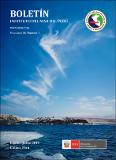Por favor, use este identificador para citar o enlazar este ítem:
https://hdl.handle.net/20.500.12958/3352| Título : | Ecología trófica de Octopus mimus Gould, 1852 y Dosidicus gigas d’Orbigny, 1835 (Cephalopoda) en el 2017 |
| Otros títulos : | Trophic ecology of Octopus mimus Gould 1852 and Dosidicus gigas d’Orbigny 1835 (Cephalopoda) in 2017 |
| Autor : | Cisneros Burga, Rosario |
| Palabras clave : | Cefalópodos;Contenido gástrico;Espectro trófico |
| Fecha de publicación : | 2019 |
| Citación : | Bol Inst Mar Perú. 34(1) 2019: p.198-222 |
| Citación : | Boletín IMARPE;34(1), 2019 |
| Resumen : | Pulpo (Octopus mimus) y calamar gigante (Dosidicus gigas) son importantes recursos comerciales, a los que entre febrero y diciembre 2017 se les determinó la composición de la dieta. La zona de estudio para O. mimus comprendió las islas frente a la bahía del Callao y frente a Ilo (Moquegua); para D. gigas fueron las zonas norte y sur durante los cruceros de investigación de verano (Cr. 1606-07) y primavera (Cr. 1711-12). Para cuantificar la dieta se utilizaron métodos de frecuencia de ocurrencia (%FO), abundancia (%N) y gravimétrico (%P). En O. mimus se analizaron las tendencias del índice de repleción (IR) por estaciones y longitud del manto (LM) y en D. gigas según arte y zona de pesca, sexo y rango de talla (LM). En el pulpo de Callao destacaron los crustáceos Petrolisthes desmarestii y Synalpheus spinifrons; en Ilo S. spinifrons y Allopetrolisthes angulosus. No se observaron diferencias en el IR según estaciones y LM. En D. gigas procedente del crucero de verano, las presas principales (%P) fueron Vinciguerria lucetia (norte), Pleuroncodes monodon (sur) con diferencias en el IR según arte y zona de pesca y LM; no hubo diferencias según sexo; en el crucero de invierno destacaron D. gigas, otros cefalópodos (norte), V. lucetia y peces mictófidos (sur). Se observó la influencia del evento El Niño Costero 2016-2017 sobre el comportamiento alimentario de ambos cefalópodos. ABSTRACT: Between February and December 2017, the diet composition was determined for the octopus (Octopus mimus) and jumbo flying squid (Dosidicus gigas). The study area for O. mimus included the islands located off the Callao Bay and off Ilo (Moquegua); for D. gigas, it covered the northern and southern areas in the summer (Cr. 1606-07) and spring (Cr. 1711-12) research cruises. The methods of frequency of occurrence (%FO), abundance (%N) and gravimetric (%P) were used to quantify the diet. In O. mimus, the modes of the fullness weight index (FWI) by seasons and mantle length (ML) were analyzed and in D. gigas, the analysis was based on fishing gear and area, sex, and length range (ML). In the octopus from Callao, the crustaceans Petrolisthes desmarestii and Synalpheus spinifrons stood out; in Ilo, S. spinifrons and Allopetrolisthes angulosus were predominant. No differences were observed in the FWI, by seasons and ML. In D. gigas from the summer cruise, the main prey (%P) were Vinciguerria lucetia (north), Pleuroncodes monodon (south) with differences in the FWI by fishing gear and area and ML; there were no differences by sex; in the winter cruise, D. gigas, other cephalopods (north), V. lucetia and myctophid fish (south) stood out. The influence of the El Niño Costero 2016-2017 on the feeding behavior of both cephalopods was observed. |
| URI : | https://hdl.handle.net/20.500.12958/3352 |
| ISSN : | 03787702 |
| Aparece en las colecciones: | Boletín 34(1), 2019 |
Ficheros en este ítem:
| Fichero | Descripción | Tamaño | Formato | |
|---|---|---|---|---|
| Boletin 34(1)-15.pdf | 1,87 MB | Adobe PDF |  Visualizar/Abrir |
Este ítem está sujeto a una licencia Creative Commons Licencia Creative Commons

